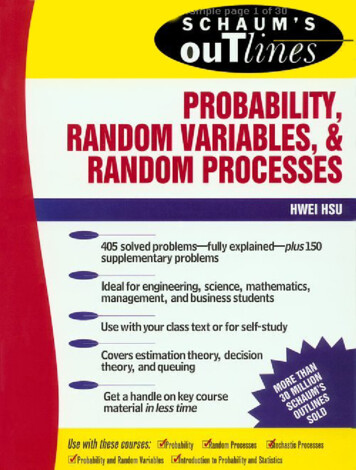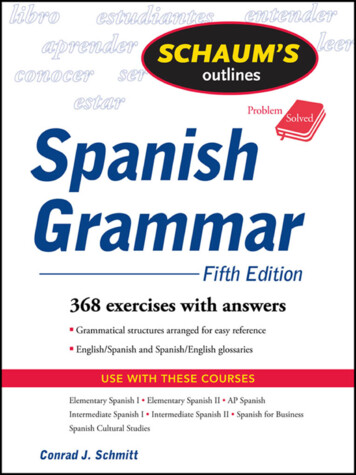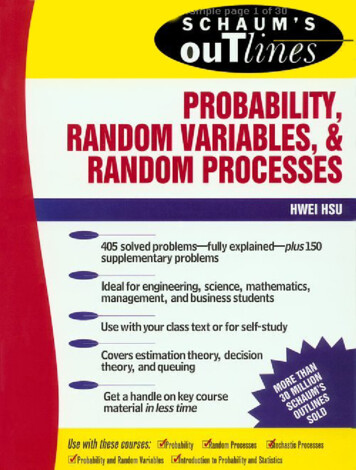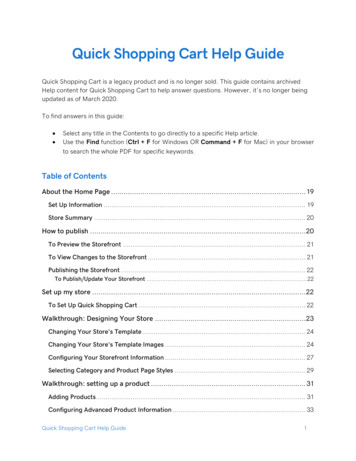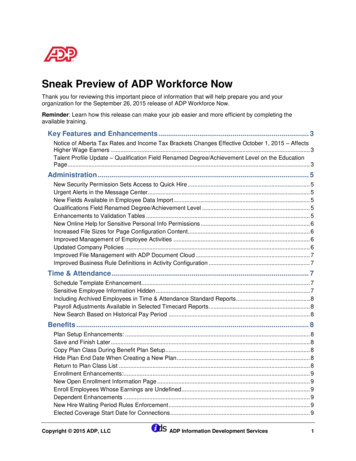
Transcription
Schaum's Quick Guideto Writing GreatShort Stories
Other Books in Schaum's Quick Guide Series include:SCHAUM'S QUICK GUIDE TO BUSINESS FORMULASSCHAUM'S QUICK GUIDE TO WRITING GREAT ESSAYSSCHAUM'S QUICK GUIDE TO GREAT PRESENTATION SKILLS
Schaum's Quick Guideto Writing GreatShort StoriesMargaret LuckeMcGraw-HillNew York San Francisco Washington, D.C. Auckland BogotaCaracas Lisbon London Madrid Mexico City MilanMontreal New Delhi San Juan SingaporeSydney Tokyo Toronto
Library of Congress Catalog Card Number: 98-067035 [ED-Insert correct #]Lucke, Margaret.Schaum's quick guide to writing great short stories / MargaretLucke.p.cm.Includes index.ISBN 0-07-039077-01. Short story-Technique. I. HillA Division of The McGraw Hill CompaniesCopyright 1999 by The McGraw-Hill Companies, Inc. All rights reserved. Printed inthe United States of America. Except as permitted under the United States CopyrightAct of 1976, no part of this publication may be reproduced or distributed in any formor by any means, or stored in a database or retrieval system, without the prior writtenpermission of the publisher.1 2 3 4 5 6 7 8 9 0DOC/DOC 9 0 3 2 1 0 9 8ISBN 0-07-039077-0The sponsoring editor for this book was Mary Loebig-Giles, the editing supervisor was FredDahl, the designer was Inkwell Publishing Services, and the production supervisor wasSherri Souffrance. It was set in Stone Serif by Inkwell Publishing Services.Printed and bound by R. R. Donnelley & Sons Company.McGraw-Hill books are available at special quantity discounts to use as premiums andsales promotions, or for use in corporate training sessions. For more information,please write to the Director of Special Sales, McGraw-Hill, 11 West 19th Street, NewYork, NY 10011. Or contact your local bookstore.This book is printed on recycled, acid-free paper containinga minimum of 50% recycled, de-inked fiber.
To Scott,as he explores the magic of creative expression
Contents1. W r i t i n g a Short Story—Getting S t a r t e d1What Is a Short Story?2Finding a Story to Write5A Short Story's Basic Ingredients10Sitting Down to Write12Exercises: Generating Ideas192. Characters—How to Create PeopleW h o Live and Breathe on the Page21Choosing a Protagonist22Choosing a Point of View23Bringing Your Characters to Life29Tip Sheet: Three-Dimensional Characters39Character's Bio Chart41Giving Your Characters a Voice42Tip Sheet: Dialogue49Exercises: Creating Characters513. Conflict—How to Devise a StoryThat Readers W o n ' t W a n t to Put Down55How Conflict Works in a Short Story56The Protagonist's Predicament57Bad Guys, Hurricanes, and Fatal Flaws60Conflict Equals Suspense63Exercises: Finding Story Conflict66vii
4. Plot and Structure—How to Shape Your Storyand Keep It Moving Forward69What Is a Plot?Four Characteristics of a PlotBuilding the Narrative StructureBeginnings, Middles, and Ends69727983Chart: Narrative StructureScenes: The Building Blocks of a Plot8492Stories without PlotsExercises: Constructing a Plot94965. Setting and Atmosphere—How to Bring Readersinto a Vivid Story World99Choosing Your SettingBringing Your Setting to Life101107Tip Sheet: Three-Dimensional SettingsExercises: Making a Setting Vivid1151186. Narrative Voice—How to DevelopYour Individual Voice As a Writer121What Is Voice?Making Your Voice Stronger122124Making Your Voice Your OwnTip Sheet: Narrative Voice132134Exercises: Discovering and Developing Your Voice138Appendix A: Suggested Reading—Exploring theRealm of Short Stories143Appendix B: When Your Story Is Written—A QuickGuide to Submitting Manuscripts for Publicationviii147Appendix C: How to Format Your Manuscript153Index157
AcknowledgmentsI would like to express my deep appreciation and gratitude to:The students in my writing classes, who have challenged andinspired me with their questions, their insights, and their wonderfulstories.My writer colleagues and friends, with whose encouragement Ihave discovered so much about what I know about writing. To mention only a few: Dave Bischoff, Lawrence Block, Janet Dawson, SusanDunlap, Syd Field, Suzanne Gold, Jonnie Jacobs, Theo Kuhlmann,Bette Golden Lamb, J.J. Lamb, Janet LaPierre, George Leonard, LynnMacDonald, Larry Menkin, Marcia Muller, Bill Pronzini, Shelley Singer,Laurel Trivelpiece, Penny Warner, Mary Wings, Judith Yamamoto, andChelsea Quinn Yarbro. There are many more, and I value them all.Mary Loebig Giles and Don Gastwirth, who gave me the opportunity to write this book.Charlie and Agness, who have been supportive, patient, and generous throughout the process, as they always are.Margaret Luckeix
Schaum's Quick Guideto Writing GreatShort Stories
Chapter 1Writing the Short StoryGetting StartedOnce upon a time—what a magical phrase. It offers an irresistibleinvitation: Settle back and listen. I'm going to tell you a story.Few pleasures are as basic and satisfying as hearing a goodstory—unless it's the pleasure of writing one.The concept of stories must have been invented as soon ashuman whoops and squeals turned into language. Stories havebeen found recorded on papyrus from ancient Egypt and in thefragments of documents that were compiled to become theJudeo-Christian Scriptures. It's possible that the smudgy cavepaintings of prehistoric eras were made to illustrate tales toldaround cooking fires about the trials and tribulations of the season's hunt. Civilizations around the globe have used stories topreserve history define heroes, and explain the caprices of thegods. The impulse to tell stories is no less strong today.Writers write for two reasons. One is that they have something they want to say. The other, equally compelling motive isthat they have something they want to find out. Writing is amode of exploration. Through stories we can examine and cometo terms with our own ideas, insights, and experiences. In theprocess of writing a story, we achieve a little better understanding of our world, our fellows, and ourselves. When someonereads what we write, we can share a bit of that understanding.What's more, writing a story can be great fun.So sharpen your pencils or fire up your computer, and let'sget started.1
What Is a Short Story?We begin with a couple of dictionary definitions. The first defines astory as "the telling of a happening or a series of connected events."Another definition of a short story is "a narrative.designed to interest, amuse, or inform the hearer or reader."These are the first of many definitions we'll encounter inthe course of this book. Each definition has its uses, althoughnone completely captures the essence of what a short story is.When taken together, they will all contribute to your sense ofwhat constitutes a short story and what makes one story satisfying to read while another is less so.We will concentrate on the traditional story—the kind thatderives its power from characters, actions, and plot; that has abeginning, a middle, and an end. Not all short stories are likethis. An advantage of the short story form is that its brevityallows variations and experiments that would be difficult to sustain throughout the much longer course of a novel. A shortstory writer can focus on sketching a character, presenting aslice of life, playing with language, or evoking a mood. Manyexcellent stories written and published today achieve theirimpact from the way the author assembles a mosaic of images orjagged fragments of experience, instead of telling an old-fashioned tale. But the traditional story provides the best vantagepoint for examining the craft of short story writing.The best way to get a solid feel for the short story as a literary form is to learn from the stories themselves. Become avoracious and eclectic reader. Read stories in abundance. Readliterary stories and stories from a variety of genres—mystery, science fiction, fantasy, horror, romance. Read classic stories byacknowledged masters and recently published works by writerswhose reputations are still developing. Read traditional storiesand experimental ones. You will gain an intuitive sense of howto make a story work.Then do the three things that are essential to becoming ashort story writer:1. Write.2. Write some more.3. Keep on writing.2
FICTION VERSUS REALITYWhen you write a short story you use the raw material ofyour imagination, your experience, and your observations abouthow life works to construct a small but complete and self-contained world. You create a sort of parallel universe that resembles the real world but differs from it in significant ways. Yourworld may mirror the real one so closely that we as readersaccept it as the one we walk around in every day, or it may deviate markedly, especially if you are writing science fiction or fantasy. As the writer, your job is to make your world so vivid andtrue that readers believe in it, no matter how preposterous itmay be when compared to reality.Two things distinguish a short story world from the actualone: In real life, events occur haphazardly, while in fiction theyhave a purpose. Because of that, a short story doesn't leave ushanging, perplexed about the outcome, the way life does. We havethe satisfaction of achieving resolution and a sense of closure.THE STORY GOALIn the two dictionary definitions already cited, the keywords are connected and designed. Unlike your holiday letter toAunt Sue, in a short story the events described are not random.The author chooses, organizes, and describes them with a designor purpose in mind. What connects the events is the contributioneach one makes to the accomplishment of this unifying goal.There are many possible story goals. You might wish toexamine some aspect of human nature, or to help yourself andyour readers understand what it's like to go through some experience. You could be striving to create a particular mood orevoke a certain emotion within your readers: This story's goingto scare the bejeebers out of them.Whatever your goal might be, it becomes the organizingprinciple of the story, giving it cohesion, coherence, and a senseof completeness. The decisions you make about the story—whothe characters are, what incidents are depicted, where the incidents take place, how the story is structured, what words arechosen to tell it—all derive from the goal. Anything extraneous,however brilliant or profound it may be, can distract both youand your reader from the purpose of the story.3
Does having a goal sound lofty and a bit daunting? Don'tworry, you don't have to climb Mount Everest. Scaling a gentleslope will do just as well. "A narrative . designed to interest,amuse, or inform the reader"—there are infinite ways, large andsmall, to interest, amuse, and inform.Nor do you need to have clearly identified your goal beforeyou start. As we noted, writing a short story is a process ofexploration—a search not only to find answers, but often to figure out what the questions are. As you plan your story and writethe early drafts, you'll gain a clearer focus on the goal you wantto pursue.RESOLUTION OR CLOSUREThe advantage of having a story goal is that it gives you adirection to head in and a destination to reach. When you arriveyou're rewarded with a sense of resolution or closure that's rarein real life. Both writer and reader get to find out how it allcomes out.This means that the major questions posed by the story getanswered before the words The End appear. It doesn't mean thatthere can be no ambiguities left, or that the reader will know forsure that the characters will (or won't) live happily ever after.But the story achieves its own kind of completeness: These connected events have reached their logical conclusion. Anythingelse that might happen belongs in a new story.A WORD ABOUT THEMESomeone may ask you, "What is the theme of your story?"and chances are you won't know what to say."Come on," this person will persist, "every story has tohave a theme."Well, perhaps. It's true that in many effective stories thesmall, specific details of the characters, the setting, and theevents that take place serve to illustrate some abstract concept orlarger idea—the nature of justice, say, or the consequences ofexploiting the environment, or the difference between romantic and parental love.Sometimes the desire to explore a certain theme providesyour initial idea, your story goal. But it may be that you will4
complete several drafts before you realize what the theme is. Infact, you can write a story that a reader will find compelling,insightful, and moving without being consciously aware of itstheme at all. The theme emerges quietly as you pay attention toall the other details of your writing art and craft.HOW LONG IS SHORT?Ideally, a short story should be exactly as long as it needsto be, and no longer or shorter. In other words, use the numberof words you need to tell the story in the most effective way.Still, there are conventions. Once you get past 20,000words or so, you are edging past the boundary of the short storyinto the realm of the novelette. Most magazines and anthologiesprefer stories that have 5,000 words or fewer. Some publishersrequest short-short stories; what they mean by this term varies,but it tends to refer to narratives of no longer than 2,000 words.In novels, word counts of 75,000 to 100,000 are typical andgreater lengths are not uncommon; you have latitude to ramble,to take side roads and detours, to reminisce or digress or offerphilosophical observations. You can span decades, even epochsas James Michener did in novels like Chesapeake and Hawaii. Youcan roam worldwide.But precisely because they are short, short stories require atighter focus. The illumination they offer is less like an overheadlight and more like a flashlight's beam. Rather than recount itsmain character's life history, the short story usually concentrates on a single relationship, a significant incident, or a defining moment.Finding a Story to WriteTo begin writing a story you need an idea. That simple requirement stops many aspiring writers before they start.Where do you get your ideas? This question has a reputation for being the one writers are most often asked, and the onesome of them are most tired of hearing. I heard one writer huff:"It's as if people expect me to name a catalog where they canorder up ideas—guaranteed to generate a good story or yourmoney back."5
But the question is worth pondering, all the more sobecause there are no pat answers. The idea is the spark thatignites the creative process, one of the most mysterious and fascinating of human endeavors.Experienced writers have ideas all the time, which is whythey may find the question perplexing and occasionally tedious.Coming up with ideas is easy; the problem is finding time to sitdown and write.The fact is, ideas are everywhere. The trick is to recognizethem and grab them as they go by.AN IDEA IS TO A WRITER.The problem, I think, is that people misunderstand therelationship between an idea and a story. An idea is anythingthat kick-starts your imagination with enough power to beginthe story creation process. It's whatever catches hold of yourmind long enough for you to think: "Hmmm. I wonder ifthere's a story in there someplace."That's all a story idea is. One thing that blocks would-bewriters is that they expect their initial idea to be larger than that,to give them more of the answers than it will. They believe thefollowing analogy to be true:An idea is to a writer as a seed is to a gardener.In other words, they think that once a writer finds an idea,the story inevitably follows. The gardening analogy suggeststhat the idea, like a seed, holds a genetic blueprint for the storythat predetermines the nature of its characters, plot, and setting,in the same way that a bulb contains the tulip or an acorn contains the future oak tree. Stick the idea in soil, sprinkle on a little water, and the story will spring up and blossom almost of itsown accord.That's a misperception. Here's a closer analogy:An idea is to a writer as flour is to a baker.A story idea really functions more like the flour you use tomake bread or pastry. It is the first ingredient, and an essentialone. But you need to choose various other ingredients, blend6
them in, and bake them all together before you have a treatthat's ready to serve.A story is an aggregation of many ideas, large and small.Each idea contributes to and yet changes the final result, likeingredients combined in a recipe. As with baking, when youwrite a story a sort of chemical reaction takes place. The finalproduct is something more than the sum of its ingredients. Itbecomes something entirely new, and the individual ingredientscan no longer be separated out.Your initial inspiration can lead you to any number of stories. What you add to the flour idea determines whether you endup creating chocolate cake or apple pie, sugar cookies or sourdough rolls.SOURCES OF IDEASThe flour idea for your story can be anything—a character,a situation or incident, an intriguing place, a theme you want toexplore. When you're lucky, story ideas just pop into your head.These are little gifts from your subconscious, and we all havemore of them than we realize. Usually they come while we arethinking about something else entirely or about nothing at all.For me they are often associated with water—ideas float into mymind when I'm swimming or taking a shower. It's a little gamemy subconscious mind plays with me, giving me ideas when Ihave no paper and pencil handy to write them down.The flour idea for my short story Identity Crisis was thiskind of brainflash: a single line of dialogue. In my mind's ear Iheard a young woman ask another: "Do I look like a corpse toyou?" All I had to do was figure out who the women were, whatprompted the question, and what they were going to do aboutthe answer. Writer Chris Rogers was nodding off to sleep onenight when a dreamlike image drifted by: a shiny Jaguar in aused car lot filled with old junkers. What's that doing there, shewondered, and the story creation process began.But you don't have to wait for your subconscious mind tofeel generous. Conduct an active search for ideas—your everydaylife is full of them. You can find them in the people youencounter, the places you go, the events you take part in or witness, the things that you read. A story might be sparked by the7
argument you have with a coworker, the memory of that embarrassing moment at your senior prom, your mother's recollectionof her eccentric Uncle Harry, a snatch of conversation you overhear from the next booth in the coffee shop, a magazine articlethat makes you wonder, "Why would people behave like that?"We are not all writers, but most of us are storytellers. Werelate stories constantly: the funny thing that happened atschool today, the time when we went camping and got lost inthe mountains. Listen to the incidents you hear yourself describing over and over, the episodes that have become part of yourhistory, the ones that leave your friends rolling their eyes andsaying, "Oh no, not this story again." If a tale engages you somuch that you repeat it to all your new acquaintances, thenthere might well be a good short story there.SYNERGY: IDEAS IN TEAMWORKThe truth is, one idea is seldom enough.Suppose you have come up with a wonderful idea on whichto base a story, one that keeps nudging at your brain, demanding to be written. But all you have is a fragment—an image of anold woman riding a train, an offhand comment made by afriend, a glimpse of an old house that surely must be haunted.The flour just sits there in the bowl, waiting for you to decideon the next ingredient.When you figure out what you want to add to the flour,that's when the story begins to come alive. The story developsfrom the synergy that occurs when two ideas mesh.Karen Cushman, author of the The Ballad of Lucy Whipple,has said that the idea for that story came to her in a museumbookstore in California's gold country. Reading about the goldrush, she was struck by the statistic that ninety percent of thepeople who flooded into California in the early 1850s weremen. That meant that ten percent were women and children,but one rarely heard about them. What would life have beenlike for a girl, she wondered, in such a rough, raw territory?Cushman herself had endured an unwelcome cross-countrymove as a child. So now she had two elements to work with:the notion of a child's perspective on an exciting moment inhistory, coupled with her own experience and feelings as a8
twelve-year-old uprooted from a familiar and comfortablehome. When these ideas teamed up, the character of LucyWhipple was born.Margaret Atwood commented in a radio interview that shethinks a lot of stories begin as questions. One that she askedherself was: "If you were going to take over the United States,how would you do it?" Another was: "If women's place isn't inthe home, how are you going to get them to go back there whenthey don't want to go?" Either question by itself had the potential to lead to an intriguing story. But it was when Atwood combined the two that the story process began in earnest, resultingin her novel, The Handmaid's Tale.THINKING STORY: THE "WHAT IF." GAMEWriters train themselves to "think story"—to look at people, places, and situations with an eye to discerning what dramatic potential they might contain.Your subconscious constantly gives you clues about whereto begin. Whenever something jiggles your mind enough tomake you think, "That's interesting." or, "I wonder.," it's asignal that a story idea is there, waiting for you to discover it.The next step is to think, "What if." Make it a game to discover the story possibilities around you.Suppose you're lunching at a cafe, and you notice a youngwoman with a green silk scarf sitting at the window table. She'sbeen there for an hour, nursing a cappuccino and impatientlylooking at her watch. What's going on?What if she's waiting for her lover? What if she has sneakedaway from her job to grab a few minutes with him, risking herboss's anger? What if she is married, meeting her lover in secret,and her mother strolls by and sees her in the cafe window? Orher husband does? What if her lover then shows up? Or what ifhe never shows up and she decides to find out why?Another scenario: What if the young woman has discoveredthat the company she works for is defrauding its clients? Whatif she has arranged to meet a police detective who is investigating similar frauds? What if the green scarf is a signal so that thedetective will recognize her, and the briefcase by her chair isfilled with incriminating documents?9
You can play the "what if." game anywhere. At the airport,as you wait for your delayed plane to board, pick one or two ofyour fellow passengers—the man in the business suit slumped inthe hard seat, perhaps, or the redheaded girl sipping coffee froma paper cup. Think story: Why are they making this trip? Whatawaits them at their final destination? How will their lives bemade difficult by this flight's being late?In line at the supermarket, contemplate the young womanbehind you with the squalling infant in her cart. Where doesshe live, and who is waiting for her there? What if she walks intoher apartment and finds her husband at home when he shouldbe at work? Or what if she's expecting her husband to greet her,but when she arrives he is gone? What if she then finds a cryptic note on the kitchen table?A volume of excellent story ideas can be delivered to yourdoorstep every day: the newspaper. Pick an article that intriguesyou and try the "what if." game. The point is not to make astory out of the actual circumstances that are described or toturn the real people involved into fictional characters. What youwant to do is isolate the basic situation and draw a brand newstory out of it. You might try working from the headline alone.For instance, suppose the headline reads: "GovernmentOfficial Is Arrested by USA on Espionage Charges." Ignore thearticle and let your imagination play. Who is this person, andwhat led him or her to become a spy? What if he's been falselyaccused and is not guilty? What if it's a case of mistaken identity? What if his boss set him up to take the fall? What if he isin fact a double agent, pretending to spy for a foreign government but really gathering information for the CIA?To get your imagination really humming, try to come upwith three or more scenarios for each person, place, or situationthat triggers a "what if."A Short Story's Basic IngredientsNow that you have an idea for a story, let's revisit our seconddictionary definition and expand on that word designed a bit.Our revised definition is this: A short story is "a short narrativein which the author combines elements of character, conflict,10
plot, and setting in an artful way to interest, amuse, or informthe reader."The four elements and the artful way in which the authorpresents them are the essential ingredients of any short story—the sugar, eggs, cinnamon, and cream that you knead togetherto turn your story idea into a bread or pastry that is tasty andsatisfying.In the following chapters, we'll take an in-depth look atthese five topics—the basic crafts of short story writing. We'llexamine the contribution each of the ingredients makes to thestory and how they interact, influencing its development. Characters. No matter how compelling your initial idea is,it won't come alive until you conjure up some imaginarypeople and hand it to them. Through their motivations,actions, and responses, they create the story. For a truly satisfying story, skip ordering up stock figures from centralcasting and breathe life into your characters, making themas solid and complex and real as you and your readers are.Chapter Two shows you how. Conflict. This is the life's blood of your story, flowingthrough it and giving it energy. The conflict you set up propels the events of the story and raises the issues that must beresolved. In taking action to deal with it, your charactersreveal themselves: their motivations, weaknesses, andstrengths. Chapter Three examines how conflict drives thestory and creates the suspense that keeps readers hookeduntil the last page. Plot and structure. The structure of a story is like the framing of a house or the skeleton inside a body: It organizes andgives shape to the disparate parts. Once you know who yourcharacters are and what conflict they face, you can explorehow you want to arrange and present the story's events,from beginning to middle to end. Although there are otherways to structure a story, Chapter Four concentrates on thetraditional method which, though it was first explored inancient times, still offers tremendous challenges and satisfactions to writers and readers alike—the construction of aneffective plot.11
Setting and atmosphere. A story's setting provides a context for its characters and events. Not only does it situatethem in time and place, but it shapes the people and influences what happens to them. It influences readers too.When your setting is vivid and your atmosphere supportsthe story's tone and mood, you bring readers right inside thestory, increasing their involvement in what's going on.Chapter Five explains how to create this you-are-there effect. Narrative voice. The first four elements constitute the who,why, what, when, and where of the story; they define whatthe story is about. The fifth element is the how, the "artfulway" the story is told.The term voice encompasses all the choices a writer makesabout language and style. It also includes the unique perspective that any author brings to his or her own work. Had ErnestHemingway and William Faulkner ever described the same set ofevents, the resulting stories would have been very different,thanks to their strong and distinctive voices.Beginner or pro, every writer has a voice, whether conscious of it or not. Novice writers often borrow someone else'svoice, and it may fit the writer no better than a suit of borrowedclothes would. One mark of a writer's growing skill is theincreased willingness to "say it my way" and to do so with careand precision. Chapter Six will help you to understand the concept of voice, and to discover and develop your own.Sitting Down to WriteOkay, you have some ideas for your story and a few thoughtsabout how to put them together. Now comes the tricky part:Writing the darn thing. Here are four important things to remember as you sit down, pen in hand or fingers on the keyboard.1. THERE ARE NO RULES.Author W. Somerset Maugham once said: "There are threerules for writing a novel. Unfortunately, no one knows whatthey are." This wise comment applies equally to short stories.12
What you read in this book (or anywhere else) are suggestions, observations, things that might offer some insight, pointsthat it might be helpful to keep in mind. As you read, you aresure to encounter plenty of stories, some of them excellent, thatdefy or contradict every key point that I make. Part of growing asa writer is honing your own instinct for what does and does notwork in a story and developing confidence in your own choices.Writing a story is a nonlinear process. You can't go fromStep One, to Step Two, to Step Three, from beginning to end,the way you would assemble a bookcase or even (despite ourearlier analogy) the way you would bake a cake. You move forward, then backward. Inward, then outward. Down side roadsand around in circles. Eventually, if you stick with it, you havefinished writing a story.A story begins with a single idea, a glimmering—somethingthat niggles at your brain and says, "Follow me." So that's whatyou do. There's no predicting where it will lead you. Many awriter, upon finishing a manuscript, realizes that the finishedproduct bears little resemblance to the story she thought shewas setting out to write. As you begin the first draft, you ma
McGraw-Hill books are available at special quantity discounts to use as premiums and sales promotions, or for use in corporate training sessions. For more information, please write to the Director of Special Sales, McGraw-Hill, 11 West 19th Str

